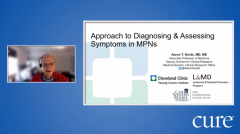
Educated Patient® MPN Summit Approach to Diagnosing & Assessing Symptoms Presentation: May 7, 2022
Watch Dr. Aaron Gerds, from Cleveland Clinic Taussig Cancer Institute, discuss approaches to diagnosing and assessing symptoms, during the CURE Educated Patient MPN Summit.
Episodes in this series

Myeloproliferative neoplasms (MPNs) — a group of blood cancers — may often present in patients who may develop a variety of symptoms that don’t always come from one place.
The challenge, according to Dr. Aaron T. Gerds, is that these occurrences of symptoms from various causes can create a complex story for patients who are diagnosed with polycythemia vera, essential thrombocytopenia and myelofibrosis — all of which are classified as MPNs.
Gerds, deputy director for Clinical Research at Cleveland Clinic Taussig Cancer Institute, recently discussed how oncologists diagnose MPNs and how certain symptoms may play a role in how they determine which disease a patient has during CURE®’s Educated Patient® MPN Summit.
“We tend to see more vascular events, meaning blood clots, in patients with (polycythemia vera) and (essential thrombocytopenia) than in myelofibrosis,” Gerds said during the presentation. “(And) we know that controlling the hematocrit (percentage of red blood cells in the blood) … can reduce the risk of having blood clots. Sometimes, this … can be unrecognized so people can have a myeloproliferative neoplasm and have it unrecognized and then ultimately have a clot even before their diagnosis.”
How Providers Make a Diagnosis
First, Gerds noted, health care providers perform a medical history and clinical examination on their patients. Labs are collected to review basic blood counts as well as to see if there are any makers for infectious diseases.
For instance, he said, they are looking to see if a patient may have had hepatitis in the past that they weren’t aware of.
“That way, when we do use treatments later on, we can avoid complication,” explained Gerds.
After these tests are performed, a bone marrow biopsy is collected.
“We really want to go to the source (and) see abnormalities, and that’s the bone marrow,” he said.
Additionally, according to Gerds, a pivotal piece to the puzzle of diagnosing an MPN is the use of molecular testing. This process, he said, has become the “centerpiece in making the diagnosis.” The reason being that mutations to the JAK2, calreticulin (CALR) and MPL genes are very common in patients with these disorders.
Polycythemia vera, for example, is often considered to be the case in patients if they have elevated bone marrow counts as well as the presence of a JAK2 mutation, which, according to Gerds, is present in upwards of 95% of patients.
MPNs are Cancer
Before discussing the common symptoms that occur in patients with MPNs, Gerds reiterated to the audience that MPNs are in fact a type of cancer.
“These mutations have occurred (which) has led to abnormal growth of cells,” he said. “Therefore, we do classify this as a type of cancer. Since it is a cancer of the blood and bone marrow, we classify this as a type of leukemia. Although, it is a chronic leukemia, meaning that patients can live many years, even without treatments.”
This notion, however, is a stark contrast to patients who develop acute leukemia. Gerds noted that acute leukemia tends to be significantly more aggressive than a chronic leukemia such as MPNs.
No ‘Discrete Bins’
The symptoms that patients may experience don’t always fall into discrete bins, which, according to Gerds, means that there’s a tremendous amount of overlap between the diseases that make up MPNs.
For instance, splenomegaly, or an enlarged spleen, is common in patients with myelofibrosis and in fact is often used as a diagnostic criterion in patients. However, Gerds explained that approximately one-third of patients with polycythemia vera will have an enlarged spleen.
“(This) can cause pain and discomfort in the abdomen, shortness of breath if (the spleen) pushes on the diaphragm, it can press on the stomach and (people may) have early satiety, meaning they fill up right away when they eat, even leading to weight loss,” he said.
The problem, Gerds expressed, is that pain doesn’t always mean that a patient has an enlarged spleen. There are times where a patient may have a smaller spleen but also be experiencing pain and discomfort in that area. This is why, he noted, that providers should take a good inventory of patient’s symptoms.
Significant Symptom Burden
In addition to early satiety and abdominal discomfort, patients may experience fatigue, inactivity, issues with concentration, night sweats, itching, bone pain and fever.
These symptoms can also be present at the time a patient presents to the provider before their diagnosis.
Polycythemia vera, Gerds highlighted, is usually associated with a significant symptom burden in patients.
“Just because you have (polycythemia vera) or (essential thrombocytopenia) doesn't mean that you're any less symptomatic than someone who has a myelofibrosis,” he said.
Moreover, people should be aware of a certain symptom that is unique to polycythemia vera.
According to Gerds, “the most famous” symptom of polycythemia vera is aquagenic pruritus, or the occurrence of itchy skin after a hot shower.
“(It) tends to be more on the trunk and central in the body, and then less common in the periphery,” he said. “But this is kind of a classic symptom that we often talk about in polycythemia vera and can be an early tip off to a diagnosis of the disease.”
Take-home Message
Gerds said that the purpose of his talk was to provide a basic foundation for what MPNs are.
The main message, he noted, is that polycythemia vera, essential thrombocytopenia and myelofibrosis are very similar, and most symptoms tend to overlap across the diseases.
“We take symptoms and what's going on with a patient, their disease risk, how big their spleen is, what symptoms (they) are having, and really use all that information to help apply the best treatments for that patient,” he said.
For more news on cancer updates, research and education, don’t forget to













